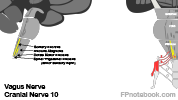II. Anatomy: Cranial Nerves 9-11
-
 Lewis (1918) Gray's Anatomy 20th ed (in public domain at Yahoo or BartleBy)
Lewis (1918) Gray's Anatomy 20th ed (in public domain at Yahoo or BartleBy)
-
 Lewis (1918) Gray's Anatomy 20th ed (in public domain at Yahoo or BartleBy)
Lewis (1918) Gray's Anatomy 20th ed (in public domain at Yahoo or BartleBy)
-
 Lewis (1918) Gray's Anatomy 20th ed (in public domain at Yahoo or BartleBy)
Lewis (1918) Gray's Anatomy 20th ed (in public domain at Yahoo or BartleBy)
III. Physiology
- Most extensive innervation of any Cranial Nerve
- Neck, thorax, Abdomen innervation
- Motor, sensory and autonomic
IV. Anatomy: Nucleii in Medulla
-
Somatic Motor Nucleii
- Nucleus Ambiguous transmits signals to pharynx for Swallowing, as well as Larynx
- Also innervates Levator Veli Palatini (raises the Soft Palate)
-
Visceral Motor Nucleii
- Dorsal Motor Nucleus CN10 innervates thoracic and abdominal viscera (via peripheral Ganglion)
-
Visceral Sensory Nucleii
- Nucleus Solitarius transmits taste signals from epiglottis
- Also transmits signals from pharynx, Larynx, trachea, Esophagus as well as thoracic and abdominal viscera
-
Somatic Sensory Nucleii
- Spinal Nucleus of CN 5 transmits signals from External Ear and dura
V. Anatomy: Course
VI. Exam
- Pharynx
- Normal: Uvula rises to phonation (Patient says "Ah")
- Paralysis: Uvula deviates toward the strong side
-
Larynx
- Laryngeal contours rise with Swallowing
-
Vocal Cord Paralysis
- Unilateral: Hoarseness
- Bilateral: Dyspnea or Inspiratory Stridor
- Indirect Laryngoscopy if indicated
VII. References
- Gilman (1989) Manter and Gatz Essentials of Neuroanatomy and Neurophysiology, Davis, p. 87-113
- Goldberg (2014) Clinical Neuroanatomy, p. 24-39
- Netter (1997) Atlas Human Anatomy, ICON Learning, p. 110-129

